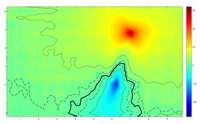New 'hearing' maps are real conversation starters

Innovative sound-mapping software based on human hearing has been developed to help architects design out unwanted noise.
The new software generates audibility maps of proposed room designs.
The EPSRC (Engineering and Physical Sciences Research Council) project has been developed at Cardiff University.
These maps show hotspots where conversations would not be intelligible if the room were busy. Architects can then adjust their designs to reduce reverberation until the hotspots are eliminated and audibility is maximised.
Software already exists to help architects predict how a building will perform acoustically for an audience in places like theatres and concert halls. This new software is specifically designed to improve the acoustic design of indoor spaces where a large number of people meet, chat and interact. It could be used for business as well as social purposes, for example, in designing open-plan offices, cafes and reception areas.
"A lot of work has been done to understand acoustics in places used for public performances," says Professor John Culling, project leader. "But little has been done to improve the acoustics of day-to-day meeting-places, even though this would help all of us in our working and social lives."
The new software also produces results much more rapidly than other acoustic software. The key to its capabilities is the unprecedented sophistication and computational efficiency of the unique mathematical equation that underpins it.
The equation has been built up using the project team's cutting-edge research looking at how people take in sound through both ears as it travels round busy rooms and how noise sources are affected by each other. This means it can accurately predict acoustic quality at every point in an indoor space where people are likely to gather and talk.
The architect will be able to call their proposed design onto their computer screen and run the software, which will ask them to specify the locations of the main sound sources in the room. An audibility map will then automatically be produced and the architect will be able to change the room's dimensions, its shape and/or the materials to be used, until hotspots are eliminated. This means that rooms could be tailor-made to suit their purpose. The work will also make a significant difference to areas where audibility is important, such as rail and airport announcement waiting areas. In emergency situations such clarity could be vital in saving lives.
The new software is intended to be used in conjunction with standard architectural computer programs widely employed in room design.
The research will also help in the future development of hearing aids and cochlear implants.
"Our objective now is to identify and work with a software company to help us develop the software further and market it," says Professor Culling. "Hopefully it will be available for architects to use within the next 12 months."

















